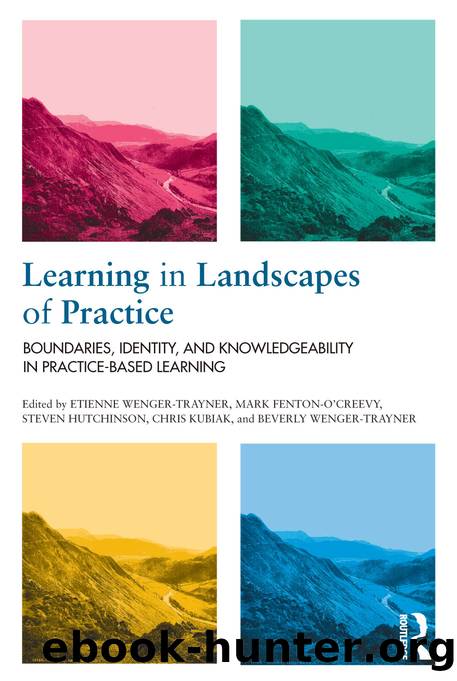Learning in Landscapes of Practice by Unknown

Author:Unknown
Language: eng
Format: epub
ISBN: 978-1-317-69252-2
Publisher: Taylor & Francis (CAM)
Chapter 5
Brokering boundary encounters
Chris Kubiak, Mark Fenton-OâCreevy, Karen Appleby, Maxine Kempster, Michael Reed, Carla Solvason and Mary Thorpe
In chapter one, Etienne and Bev argued that knowledgeability is more than competence within a single community of practice. Knowledgeability reflects a personâs connection with a multiplicity of practices across the landscape. Educators aiming to develop knowledgeable practitioners might organize learning programmes in which students engage with a range of practices from the landscape. They may draw in a range of resources from outside the academy â research material, policy documents or case material, for example. Visiting speakers such as practitioners or service users may reflect important parts of the landscape. Ellie and Alisonâs story in Chapter four is one such example. Their fine arts programme included a course taught by a visiting artist who helped students understand the practicalities of a working life in the fine arts. Educators may also create opportunities for learners to engage in learning activities in different parts of the landscape. For example, many courses require students to take workplace placements as part of their study.
Developing knowledgeability involves facilitating cross-boundary learning experiences. Facilitating such experiences often involves brokering. As Burt (2005) and Wenger (1998) both explain, brokers work at the boundaries of the landscape building connections between different practices, introducing practices from elsewhere and facilitating cross-boundary experiences. Brokers strive to support boundary crossing by facilitating the translation, coordination and alignment of different perspectives and meanings (Wenger, 1998).
This chapter explores the role of brokering in creating learning experiences by focusing on three questions:
What is it that brokers do to facilitate the development of knowledgeability? Communities of practice have particular purposes and ways of doing things which may not be shared between different parts of the landscape. Educational research is replete with examples of those in learning settings preferring to focus on their particular interests rather than incorporate concerns or practices from elsewhere. As discussed in earlier chapters, boundaries are often places of misunderstanding and confusion. Crossing a boundary or introducing an idea from elsewhere in the landscape can result in feelings of inadequacy, personal failure or disengagement. What brokering processes and skills are involved in enabling successful cross-boundary encounters or reflection on practices from elsewhere in the landscape?
How do boundary objects support boundary encounters and enable points of connection? Boundary objects enable collaborative working and sharing of practice across the landscape. They facilitate communication and coordination by providing a structure to align activity which is meaningful to all involved (Oborn & Dawson, 2010). For example, a blueprint is a boundary object which enables the different occupational groups involved in construction to plan and coordinate their actions (Star, 2010). Similarly, the Network Learning Communities programme introduced the âlevels of learningâ model to provide schools, universities and local authorities with a shared language and frame of reference to plan together and share practice (Hadfield, 2005). There are different types of boundary objects â standardized forms for sharing information between organizations, libraries, maps, common languages, concepts, theories and models of the world (Benn et al.
Download
This site does not store any files on its server. We only index and link to content provided by other sites. Please contact the content providers to delete copyright contents if any and email us, we'll remove relevant links or contents immediately.
Papillon by Henry Charrière(804)
Watercolor With Me in the Forest by Dana Fox(594)
The Story of the Scrolls by The Story of the Scrolls; the M(560)
This Is Modern Art by Kevin Coval(462)
A Theory of Narrative Drawing by Simon Grennan(460)
Frida Kahlo by Frida Kahlo & Hayden Herrera(450)
Boris Johnson by Tom Bower(446)
Banksy by Will Ellsworth-Jones(437)
AP Art History by John B. Nici(433)
Van Gogh by Gregory White Smith(429)
The Art and Science of Drawing by Brent Eviston(428)
Draw More Furries by Jared Hodges(425)
Glittering Images: A Journey Through Art From Egypt to Star Wars by Camille Paglia(423)
War Paint by Woodhead Lindy(418)
Scenes From a Revolution by Mark Harris(415)
100 Greatest Country Artists by Hal Leonard Corp(394)
Ecstasy by Eisner.;(393)
Young Rembrandt: A Biography by Onno Blom(376)
Theater by Rene Girard(358)
